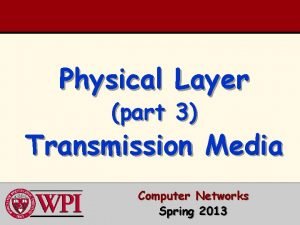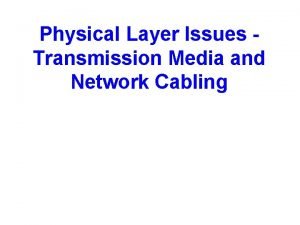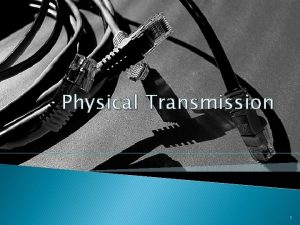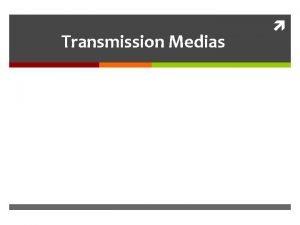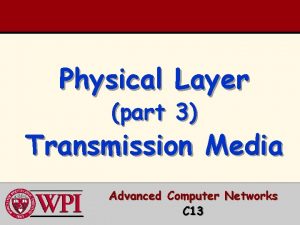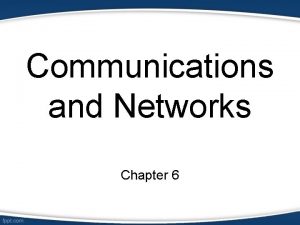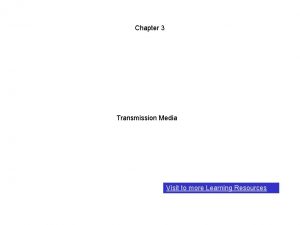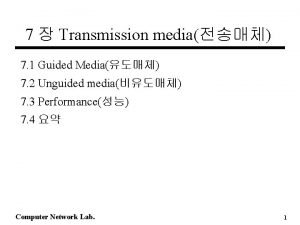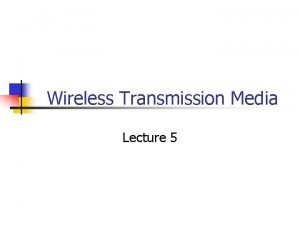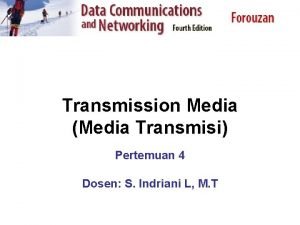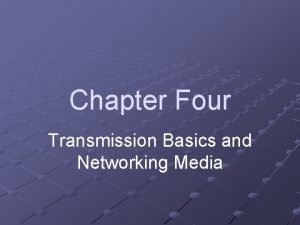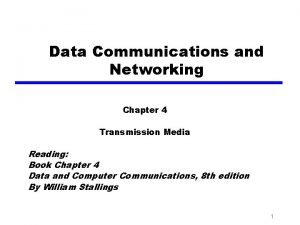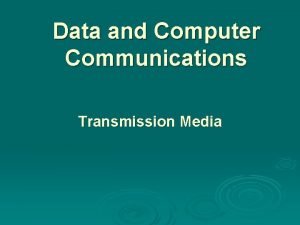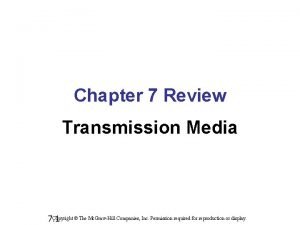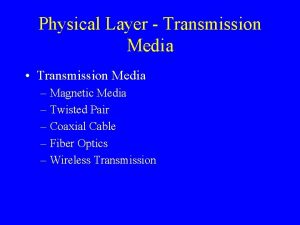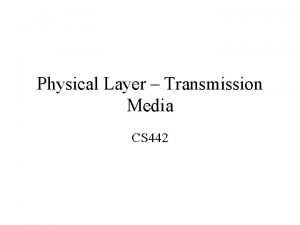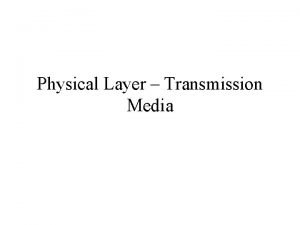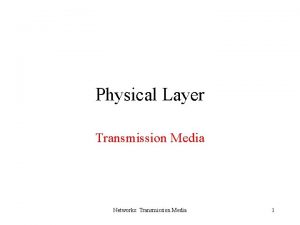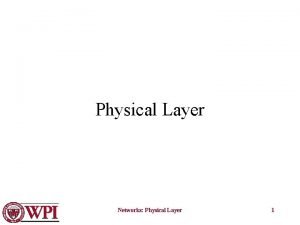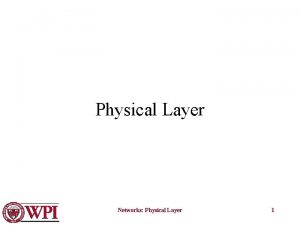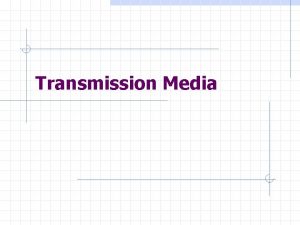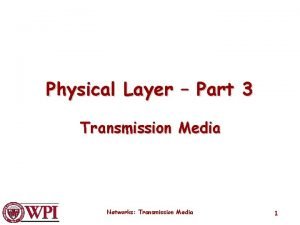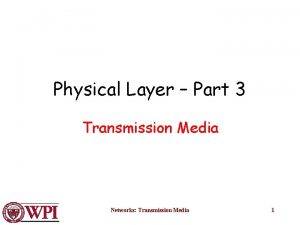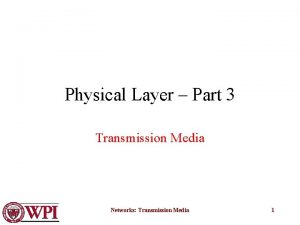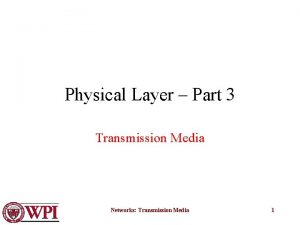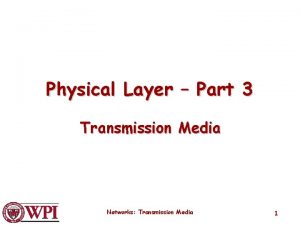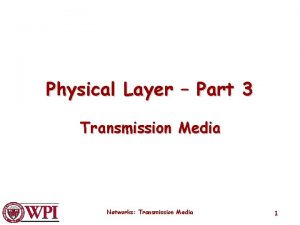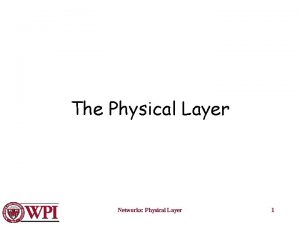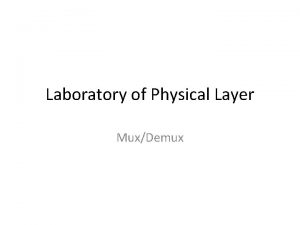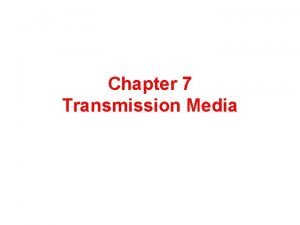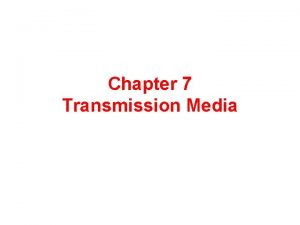THE PHYSICAL LAYER Transmission physical media For the






























































- Slides: 62

THE PHYSICAL LAYER Transmission (physical ) media For the transmission of bit stream from one machine to another, various physical media can be used l They differ in terms of bandwidth, delay, cost, easy of installation and maintenance l 9/16/2021 Sam_CN_UNIT- Ib 1

Transmission (physical) media Transmission media can be divided into 2 types, guided media and unguided media l Guided media – Magnetic media, Twisted Pair (copper wire), Coaxial Cable and fiber optics l Unguided media - radio, Microwave, Infrared and light wave transmission l 9/16/2021 Sam_CN_UNIT- Ib 2

Guided transmission media Magnetic media l One of the most common ways to transport data from one computer to another is to write them onto magnetic tapes or floppy disks, physically transport the tapes or disks to the destination machine and read them back in again 9/16/2021 Sam_CN_UNIT- Ib 3

Guided Media: Twisted Pair Twisted pair is the oldest and still most common transmission medium used in telephone system l It consists of two insulated copper wires, typically about 1 mm thick. The wires are twisted together to reduce electrical interference from similar pairs close by l Twisted pairs can run several km without amplification, but for longer distances repeaters are needed l Twisted pairs can be used for either analog or digital transmission. The bandwidth depends on the thickness of the wire and the distance traveled (several mbps for a few km can be achieved) l 9/16/2021 Sam_CN_UNIT- Ib 4

(a) Category 3 TP (b) Category 5 TP Ø Twisted pair cabling comes in several varieties, two of which are important for computer networks: Ø Category 3 twisted pairs - gently twisted, 4 pairs typically grouped together in a plastic sheath Ø Category 5 twisted pairs - introduced in 1988. More twists per cm than category 3 and teflon insulation, which results in less crosstalk and better quality signal over longer distances 9/16/2021 Sam_CN_UNIT- Ib 5

Guided Media: Coaxial Cable l Coaxial cable or coax is a copper-cored cable surrounded by a heavy shielding and is used to connect computers l l l Outer conductor shields the inner conductor from picking up stray signal from the air High bandwidth (1 to 2 Gbps) but lossy channel Repeater is used to regenerate the weakened Category Impedance Use signals Two kinds of coaxial cables RG-59 75 W Cable TV are widely used: 50 W Thin Ethernet Baseband(50 -ohm) - used for RG-58 digital transmissions Thick RG-11 50 W Broadband(75 -ohms) - used Ethernet for analog transmissions 9/16/2021 Sam_CN_UNIT- Ib 6

Guided media: Fiber Optics Optical fibers use light to send information through the optical medium. l It uses the principal of total internal reflection l Modulated light transmissions are used to transmit the signal l 9/16/2021 Sam_CN_UNIT- Ib 7

Fiber Optic Networks Ø Fiber optics can be used for LANs as well as for long-haul transmission Ø Tapping onto it is more complex than connecting to a copper wire Figure: A fiber optic ring with active repeaters 9/16/2021 Sam_CN_UNIT- Ib 8

Guided media: Fiber Optics (cont’d) l l l Light travels through the optical media by the way of total internal reflection Modulation scheme used is intensity modulation Two types of Fiber media : Single and Multimode Fiber can support less bandwidth than Single mode Fiber has a very small core and carry only one beam of light. It can support Gbps data rates over > 100 Km without using repeaters 9/16/2021 Sam_CN_UNIT- Ib 9

Single and Multimode Fiber l Single-mode fiber l Carries light pulses along single path l Uses Laser Light Source l Multimode fiber l Many pulses of light generated by LED travel at different angles 9/16/2021 Sam_CN_UNIT- Ib 10

Comparison of Fiber Optics and Copper wire Advantages of fibers: l much higher bandwidth l low attenuation (30 km distance of repeaters vs. 5 km for copper) l noise-resistance l not affected by corrosive chemicals l much lighter than copper - easier installation and maintenance l difficult to tap - higher security Disadvantages of fiber: l unfamiliar technology so far l unidirectional communication l more expensive interfaces than electrical ones 9/16/2021 Sam_CN_UNIT- Ib 11

Unguided (Wireless) Transmission media l Very useful in difficult terrain where cable laying is not possible Provides mobility to communication nodes l Right of way and cable laying costs can be reduced l Susceptible to rain, atmospheric variations and objects in transmission path l 9/16/2021 Sam_CN_UNIT- Ib 12

Unguided (Wireless) Transmission media l l l Indoor : 10 – 50 m : Blue. Tooth, WLAN Short range Outdoor : 50 – 200 m: WLAN Mid Range Outdoor : 200 m – 5 Km : GSM, CDMA, WLAN Point-to-Point, Wi-Max Long Range Outdoor : 5 Km – 100 Km : Microwave Point-to-Point Long Distance Communication : Across Continents : Satellite Communication 9/16/2021 Sam_CN_UNIT- Ib 13

Unguided (Wireless) Transmission media The Electromagnetic Spectrum: The amount of information that an electromagnetic wave can carry is related to its bandwidth. With current technology, it is possible to encode a few bits per hertz at low frequencies 9/16/2021 Sam_CN_UNIT- Ib 14

Unguided media: The Electromagnetic Spectrum Band Range Propagatio n Application VLF 3– 30 KHz Ground Long-range radio navigation LF 30– 300 KHz Ground Radio beacons and navigational locators MF 300 KHz– 3 MHz Sky AM radio HF 3– 30 MHz Sky Citizens band (CB), ship/aircraft communication VHF 30– 300 MHz Sky and line-of-sight VHF TV, FM radio UHF 300 MHz– 3 GHz Line-ofsight UHF TV, cellular phones, paging, satellite SHF 3– 30 GHz Line-ofsight Satellite communication EHF 30– 300 GHz 9/16/2021 Line-ofsight Sam_CN_UNIT- Ib Long-range radio navigation 15

Unguided media: Radio wave transmission Radio waves are easy to generate, can travel long distance, and penetrate buildings easily, so they are widely used for communication, both indoors and outdoors. l Radio waves are also omnidirectional, meaning that they travel in all directions from the source, so that the transmitter and receiver do not have to be carefully aligned physically l 9/16/2021 Sam_CN_UNIT- Ib 16

Unguided media: Radio wave transmission In the VLF, and MF bands, radio waves follow the curvature of the earth l 9/16/2021 Sam_CN_UNIT- Ib 17

Unguided media: Radio wave transmission l 9/16/2021 In the HF they bounce off the ionosphere Sam_CN_UNIT- Ib 18

Unguided media: Microwave transmission Above 100 MHz, the waves travel in straight lines and can therefore be narrowly focused. Concentrating all the energy into a small beam using a parabolic antenna gives a much higher signal to noise ratio l Since the microwaves travel in a straight line, if the towers are too far apart, the earth will get in the way. Consequently, repeaters are needed periodically l 9/16/2021 Sam_CN_UNIT- Ib 19

Unguided media: Microwave transmission Disadvantages: l do not pass through buildings well l multipath fading problem (the delayed waves cancel the signal) l absorption by rain above 8 GHz l severe shortage of spectrum Advantages: l no right way is needed (compared to wired media) l relatively inexpensive l simple to install 9/16/2021 Sam_CN_UNIT- Ib 20

Unguided media: Infrared and Millimeter Waves Unguided infrared and millimeter waves are widely used for short-range communication. l The remote controls used on televisions, VCRs, and stereos all use infrared communication l They are relatively directional, cheap, and easy to build, but have a major drawback: they do not pass through solid objects l This property is also a plus. It means that an infrared system in one room will not interfere with a similar system in adjacent room. It is more secure against eavesdropping l 9/16/2021 Sam_CN_UNIT- Ib 21

Unguided media: Light wave transmission A modern application is to connect LANs in two buildings via lasers mounted on their rooftops l It offers very high BW and very low cost l Affected by fog or rain 9/16/2021 Sam_CN_UNIT- Ib 22

Switching: Circuit switching Two different switching techniques are used inside the telephone system: circuit switching and packet switching l When a user place a telephone call, the switching equipment within the telephone system seeks out a physical "copper" (including fiber and radio) path from the caller telephone to the callee telephone. This technique is called circuit switching (Fig. (a)). l An important property of circuit switching is the need to set up an end-to-end path before any data can be sent. l 9/16/2021 Sam_CN_UNIT- Ib 23

Switching: Circuit switching (cont’d) l It takes some set-up time during which there is no data transmission in progress. Long set-up times are for many computer applications undesirable 9/16/2021 Sam_CN_UNIT- Ib 24

Message switching An alternative switching strategy is message switching (Fig (b)). It was first used for telegram l In this case, no physical copper path is established in advance. Instead, the store-andforward technique for the entire messages is applied. l With message switching, there is no limit on block size, which means that routers must have disks to buffer long blocks. It also means that a single block may tie up a router-router line for minutes, rendering message switching useless for interactive traffic l 9/16/2021 Sam_CN_UNIT- Ib 25

Packet switching To get around these problems of circuit switching, packet switching was invented l Packet-switching networks place a tight upper limit on block size l 9/16/2021 Sam_CN_UNIT- Ib 26

Packet switching (cont’d) So no user can monopolize any transmission line very long and therefore these networks are well suited to handle interactive traffic. l A further advantage of packet switching over message switching is (Fig. (c)) that the first packet of a multipacket message can be forwarded before the second has fully arrived, reducing delay and improving throughput. l For these reasons, computer networks are usually packet switched, occasionally circuit switched, but never message switched l 9/16/2021 Sam_CN_UNIT- Ib 27

(a) Circuit switching (b) Message switching (c) Packet switching 9/16/2021 Sam_CN_UNIT- Ib 28

A comparison of circuit switched and packet-switched networks 9/16/2021 Sam_CN_UNIT- Ib 29

Encoding techniques: Line coding l It is the process of converting binary data to a digital signal 0101110 Line coding The number of values allowed in a particular signal as the number of signal values l The number of values used to represent data as the number of data levels l 9/16/2021 Sam_CN_UNIT- Ib 30

1 0 1 1 0 0 0 1 Two signal levels , two data levels 1 0 0 0 0 1 Three signal levels, Two data levels 9/16/2021 Sam_CN_UNIT- Ib 31

DC Component l Some line coding schemes leave a residual direct-current (dc) component (zero- frequency) l This component is undesirable for 2 reasons: l 1. If the signal is to pass through a system that does not allow the passage of a dc component, the signal is distorted and may create errors in the output. 9/16/2021 Sam_CN_UNIT- Ib 32

2. This component is extra residing on the line and is useless 1 0 1 1 0 0 0 1 Signal with dc component 1 0 1 1 0 0 0 1 Signal without dc component 9/16/2021 Sam_CN_UNIT- Ib 33

DC Component The first signal has a dc component; the positive voltages are not cancelled by the –ve voltages l The second has no dc component; the +ve voltages are canceled by any –ve voltages l The first does not pass through a transformer properly, the second does l 9/16/2021 Sam_CN_UNIT- Ib 34

Line coding schemes Line coding Unipolar Polar Bipolar Line coding NRZ 9/16/2021 RZ Manchester Sam_CN_UNIT- Ib Differential Manchester 35

l Unipolar: uses only one voltage level 1 0 1 1 0 0 0 1 Polar: Uses 2 voltage levels. one positive and one negative 9/16/2021 Sam_CN_UNIT- Ib 36

POLAR: NRZ ( Non-Return-to-Zero) Codes 2 popular forms are used, NRZ-L and NRZ-I l Uses two different voltage levels (one positive and one negative) as the signal elements for the two binary digits. 1. NRZ-L(NRZ-Level) l +ve voltage – 0 l -ve voltage – 1 l The voltage is constant during the bit interval l NRZ-L is used for short distances between terminal and modem or terminal and computer l 9/16/2021 Sam_CN_UNIT- Ib 37

POLAR : NRZ- I (Non-Return-to-Zero-Invert on ones) 2. NRZ-I: It is the transition between +ve and –ve voltage. l Signal change each time when a 1 is encountered. l 0 bit is represented by no change. 9/16/2021 Sam_CN_UNIT- Ib 38

Manchester encoding Uses an inversion at the middle of each bit interval for both synchronization and bit representation l A negative-to-positive transition represents a binary 1 l A positive-to-negative transition represents a binary 0 l Used in 802. 3 baseband coaxial cable and CSMA/CD twisted pair l 9/16/2021 Sam_CN_UNIT- Ib 39

Differential Manchester Encoding l l l The inversion at the middle of the bit interval is used for synchronization, but the presence or absence of an additional transition at the beginning of the interval is used to identify the bit Transition means 0 No transition means binary 1 This coding is the opposite convention from NRZ -I Used in 802. 5 (token ring) with twisted pair 9/16/2021 Sam_CN_UNIT- Ib 40

1 0 1 1 0 0 0 1 MANCHESTER 1 0 1 1 0 0 0 1 DIFFERENTIAL MANCHESTER 9/16/2021 Sam_CN_UNIT- Ib 41

Bipolar encoding l l l Uses three levels: +ve, zero and –ve. Zero level – 0 1 s are represented by alternating positive and negative voltages even if the 1 s are not consecutive A common bipolar encoding scheme is called bipolar alternate mark inversion (AMI) Mark – 1. neutral zero voltage – 0 9/16/2021 Sam_CN_UNIT- Ib 42

1 0 1 1 1 0 0 Unipolar NRZ Polar NRZ-Inverted (Differential Encoding) Bipolar Encoding Manchester Encoding Differential Manchester Encoding 9/16/2021 Sam_CN_UNIT- Ib 43

Integrated Services Digital Network (ISDN) ISDN stands for Integrated Services Digital Network l Its primary goal is to integrate the voice and nonvoice services l The key ISDN service will continue to be voice but with many enhanced features l 9/16/2021 Sam_CN_UNIT- Ib 44

ISDN services l l l Telephones with multiple buttons for instant call setup to arbitrary telephones anywhere in the world displaying the caller's telephone number, name and address while ringing connecting the telephone to a computer enabling the caller's database record to be displayed on the screen as the call comes in call forwarding conference calls worldwide on line medical, burglar, and smoke alarms giving the address to speed up response 9/16/2021 Sam_CN_UNIT- Ib 45

ISDN Architecture 9/16/2021 Sam_CN_UNIT- Ib 46

ISDN Architecture (cont’d) l l l The key idea behind ISDN is that of the digital bit pipe between the customer and the carrier through which bits flow in both directions. Whether the bits originate from a digital telephone, a digital terminal, a digital facsimile machine, or some other device is irrelevant. The digital bit pipe can support multiple independent channels by time division multiplexing of the bit stream. Two principal standards for the bit pipe have been developed: a low bandwidth standard for home use, and a higher bandwidth standard for business use that supports multiple channels identical to the home use channels 9/16/2021 Sam_CN_UNIT- Ib 47

ISDN Architecture (cont’d) Normal configuration for a home consists of a network terminating device NT 1 (Fig. (a)) placed on the customer's premises and connected to the ISDN exchange in the carrier's office using the twisted pair previously used to connect the telephone. l The NT 1 box has a connector into which a bus cable can be inserted. Up to 8 ISDN telephones, terminals, alarms, and other devices can be connected to the cable. l From the customer's point of view, the network boundary is the connector on NT 1 l 9/16/2021 Sam_CN_UNIT- Ib 48

ISDN Architecture (cont’d) l l l For large businesses, the model of Fig. (b) is used. There is a device NT 2 called PBX (Private Branch e. Xchange - conceptually the same as an ISDN switch) there connected to NT 1 and providing the interface for ISDN devices. CCITT defined four reference points (Fig. ): U reference point = connection between the ISDN exchange and NT 1, T reference point = connector on NT 1 to the customer, S reference point = interface between the ISDN PBX and the ISDN terminal, R reference point = the connection between the terminal adapter and non-ISDN terminal. 9/16/2021 Sam_CN_UNIT- Ib 49

The ISDN Interface l The ISDN bit pipe supports multiple channels interleaved by time division multiplexing. Several channel types have been standardized: A - 4 k. Hz analog telephone channel B - 64 kbps digital PCM channel for voice or data C - 8 or 16 kbps digital channel for out-ofband signaling D - 16 kbps digital channel for out-of-band signaling E - 64 kbps digital channel for internal ISDN signaling H - 384, 1536, or 1920 kbps digital channel. 9/16/2021 Sam_CN_UNIT- Ib 50

The ISDN Interface (cont’d) Three combinations have been standardized so far: l Basic rate: 2 B + 1 D. It should be viewed as a replacement for POTS (Plain Old Telephone Service). Each of the 64 kbps B channels can handle a single PCM voice channel with 8 bits samples made 8000 times per second. D channel is for signaling (i. e. , to inform the local ISDN exchange of the address of the destination). The separate channel for signaling results in a significantly faster setup time. l Primary rate: 23 B + 1 D (US and Japan) or 30 B + 1 D (Europe). It is intended for use at the T reference point for businesses with a PBX. l Hybrid: 1 A + 1 C l 9/16/2021 Sam_CN_UNIT- Ib 51

The ISDN Interface (cont’d) l Because ISDN is so focused on 64 kbps channels, it is referred to as N-ISDN (Narrowband ISDN), in contrast to broadband ISDN (ATM) Fig. (a) Basic rate digital pipe. (b) Primary rate digital pipe. 9/16/2021 Sam_CN_UNIT- Ib 52

Broadband ISDN and ATM The N-ISDN was not going to solve the actual communication problems, it tried to think of a new service l The result was broadband ISDN (B-ISDN), basically a digital virtual circuit for moving fixedsized packets (cells) at 155 Mbps l Broadband ISDN is based on ATM technology that is fundamentally a packet-switching technology l 9/16/2021 Sam_CN_UNIT- Ib 53

Virtual Circuits versus Circuit Switching l l l The basic broadband ISDN service is a compromise between pure circuit switching and pure packet switching The actual service offered is connection oriented, but it is implemented internally with packet switching Two kinds of connections are offered: Permanent virtual circuits - ordered by customers at carriers, remain in place for long time Switched virtual circuits - set up dynamically like telephone calls 9/16/2021 Sam_CN_UNIT- Ib 54

Virtual Circuits versus Circuit Switching The advantage of permanent over a switched virtual circuit is that there is no setup time, packets along permanent circuit can move instantly l In a virtual circuit network, like ATM, when a circuit is established, what really happens is that route is chosen from source to destination, and all the switches (i. e. , routers) along the way make table entries so that they can route any packet on that virtual circuit (Fig. ). When a packet comes along, the switch inspects the packet header to find out which virtual circuit it belongs to. Then it looks up that virtual circuit in its tables to determine which communication line to send on l 9/16/2021 Sam_CN_UNIT- Ib 55

Virtual circuit Fig. The dotted line shows a virtual circuit. It is simply defined by table entries inside the switches. 9/16/2021 Sam_CN_UNIT- Ib 56

Transmission in ATM Networks ATM stands for Asynchronous Transfer Mode. This mode can be contrasted with the synchronous T 1 carrier (Fig. ). 9/16/2021 Sam_CN_UNIT- Ib 57

Transmission in ATM Networks T 1: frames are generated precisely every 125 sec. This rate is governed by a master clock. Slot k of each frame contains 1 byte of data from the same source. l ATM: has no requirements that cells rigidly alternate among the various sources. Cells arrive randomly from different sources. The stream of cells need not be continuous. Gaps between the data are filled by special idle cells. l ATM does not standardize the format for transmitting cells. Cells are allowed to be sent individually l 9/16/2021 Sam_CN_UNIT- Ib 58

Transmission in ATM Networks l l l In the original ATM standard, the primary rate was 155. 52 Mbps, with an additional rate at four time that speed (622. 08 Mbps). These rates were chosen to be compatible with SONET. ATM over T 3 (44. 736 Mbps) and FDDI (100 Mbps) is also foreseen. The transmission medium for ATM is normally fiber optics, but for runs under 100 m, coax or category 5 twisted pair are also acceptable. Each link goes between a computer and an ATM switch, or between two ATM switches. So, all ATM links are point-to-point. Each link is unidirectional. For full-duplex operation, two parallel links are needed. 9/16/2021 Sam_CN_UNIT- Ib 59

B-ISDN ATM Reference Model 9/16/2021 Sam_CN_UNIT- Ib 60

B-ISDN ATM Reference Model It consists of 3 layers: Physical, ATM and ATM Adaptation Layer (AAL) plus what ever the user wants to put on top of that Physical Layer: Deals with physical medium: voltages, bit timing, media. l It has 2 sub layers 1. Transmission convergence sub layer: Frame Generation. 2: Physical Medium Dependent sub layer: Flow of bits for cables ATM Layer: Deals with cells and cell transport. It defines the layout of a cell and tells what the header field mean. It also deals with establishment and release of virtual circuits. Congestion control too l 9/16/2021 Sam_CN_UNIT- Ib 61

B-ISDN ATM Reference Model ATM Adaptation Layer: l As most of the applications doesn’t deal with cells directly, a layer above the ATM layer has been defined to allow users to send packets larger than a cell. l The ATM interface segments these packets, transmits the cells individually and reassembles them at the other end l It has 2 sub layers CS: Convergence Sub layer: Application Support SAR: Segmentation and reassemble sub layer. l It packs the information received from cs into cells for transmission 9/16/2021 Sam_CN_UNIT- Ib 62
 Physical layer transmission media
Physical layer transmission media Transmission medias
Transmission medias Physical transmission media used for network cabling
Physical transmission media used for network cabling Physical transmission media
Physical transmission media Components of computer network
Components of computer network Pigmented layer and neural layer
Pigmented layer and neural layer Chemical digestion
Chemical digestion Secure socket layer and transport layer security
Secure socket layer and transport layer security Layer 6 presentation layer
Layer 6 presentation layer Secure socket layer and transport layer security
Secure socket layer and transport layer security Secure socket layer and transport layer security
Secure socket layer and transport layer security Secure socket layer and transport layer security
Secure socket layer and transport layer security Layer 2 e layer 3
Layer 2 e layer 3 Layer-by-layer assembly
Layer-by-layer assembly Layer 2 vs layer 3 bitstream
Layer 2 vs layer 3 bitstream What are the two types of transmission media?
What are the two types of transmission media? Transmission medias
Transmission medias What are the two types of transmission media?
What are the two types of transmission media? Transmission media in data communication
Transmission media in data communication Guided media types
Guided media types What is a wireless transmission media
What is a wireless transmission media Transmission media
Transmission media Transmission basics and networking media
Transmission basics and networking media Transmission medias
Transmission medias Transmission medium
Transmission medium Name the two major categories of transmission media
Name the two major categories of transmission media Iso 22301 utbildning
Iso 22301 utbildning Typiska drag för en novell
Typiska drag för en novell Tack för att ni lyssnade bild
Tack för att ni lyssnade bild Returpilarna
Returpilarna Varför kallas perioden 1918-1939 för mellankrigstiden?
Varför kallas perioden 1918-1939 för mellankrigstiden? En lathund för arbete med kontinuitetshantering
En lathund för arbete med kontinuitetshantering Särskild löneskatt för pensionskostnader
Särskild löneskatt för pensionskostnader Personlig tidbok fylla i
Personlig tidbok fylla i Sura för anatom
Sura för anatom Vad är densitet
Vad är densitet Datorkunskap för nybörjare
Datorkunskap för nybörjare Tack för att ni lyssnade bild
Tack för att ni lyssnade bild Debatt mall
Debatt mall Magnetsjukhus
Magnetsjukhus Nyckelkompetenser för livslångt lärande
Nyckelkompetenser för livslångt lärande Påbyggnader för flakfordon
Påbyggnader för flakfordon Tryck formel
Tryck formel Publik sektor
Publik sektor Jag har nigit för nymånens skära text
Jag har nigit för nymånens skära text Presentera för publik crossboss
Presentera för publik crossboss Jiddisch
Jiddisch Vem räknas som jude
Vem räknas som jude Treserva lathund
Treserva lathund Luftstrupen för medicinare
Luftstrupen för medicinare Claes martinsson
Claes martinsson Centrum för kunskap och säkerhet
Centrum för kunskap och säkerhet Byggprocessen steg för steg
Byggprocessen steg för steg Mat för idrottare
Mat för idrottare Verktyg för automatisering av utbetalningar
Verktyg för automatisering av utbetalningar Rutin för avvikelsehantering
Rutin för avvikelsehantering Smärtskolan kunskap för livet
Smärtskolan kunskap för livet Ministerstyre för och nackdelar
Ministerstyre för och nackdelar Tack för att ni har lyssnat
Tack för att ni har lyssnat Referat mall
Referat mall Redogör för vad psykologi är
Redogör för vad psykologi är Matematisk modellering eksempel
Matematisk modellering eksempel Tack för att ni har lyssnat
Tack för att ni har lyssnat

